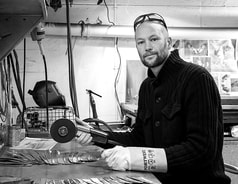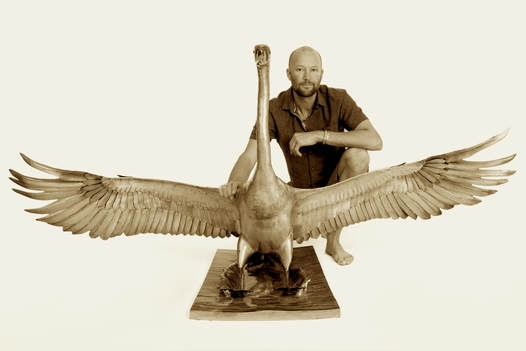I Formally trained as a painter, but a chance sequence of events led me to sculpture. I realised then that my perception of space and movement was not a flat interpretation but something tangible, fluid but almost solid at the same time.
When I sculpt, I feel atoms and particles, the very essence of the material moving and assembling into order. In life I see these particles dancing and celebrating existence.
The building blocks of life are literally in my hands. Hard, rigid and seemingly unyielding sheets of metal, bent, folded, melted and formed into shape.
Like you, I am a product of millions of years of evolution, constructing and giving emotional values and labels to these particles.
Being able to recreate the incredible manifestations that life has evolved into is a most exciting feeling for me.
I have always had a fascination with animals and their environment, but this became heightened after living and working with communities in the Maasai Mara in Kenya and witnessing the fragility of it all. This inspires me to recreate endangered species. The painstaking detail is almost a kind of worship of the sheer beauty that abounds us.
When I sculpt, I feel atoms and particles, the very essence of the material moving and assembling into order. In life I see these particles dancing and celebrating existence.
The building blocks of life are literally in my hands. Hard, rigid and seemingly unyielding sheets of metal, bent, folded, melted and formed into shape.
Like you, I am a product of millions of years of evolution, constructing and giving emotional values and labels to these particles.
Being able to recreate the incredible manifestations that life has evolved into is a most exciting feeling for me.
I have always had a fascination with animals and their environment, but this became heightened after living and working with communities in the Maasai Mara in Kenya and witnessing the fragility of it all. This inspires me to recreate endangered species. The painstaking detail is almost a kind of worship of the sheer beauty that abounds us.

Biography for Kew Gardens exhibition sept 2017
Written by Nadia Sitas
Piers was born 1974 and grew up in the New Forest.
He studied Fine Art at S.t Albans and Winchester, M.A.
He currently lives in East Sussex but lived and worked in the Maasai Mara, Kenya for five years where he developed an awareness of environmental issues and the fragility of our ecosystems and endangered species.
Piers has unparalleled attention to detail and form with unique materials and techniques. He explores the boundaries of traditional sculpture while working with marine grade stainless steel, brass and copper which enables him to create strikingly naturalistic pieces. He uses recycled metals in a way that belies its past, drawing your attention away from the material, shifting your focus to the character and soul of the animals he creates. Many of the pieces are born from personal experiences - riding through African plains alongside crested cranes, sitting in fields with barn owls silently gliding past, or diving with inquisitive turtles. His pieces inspire a personal interaction for the viewer on a deeper level, encouraging us to re-connect with our natural world.
Written by Nadia Sitas
Piers was born 1974 and grew up in the New Forest.
He studied Fine Art at S.t Albans and Winchester, M.A.
He currently lives in East Sussex but lived and worked in the Maasai Mara, Kenya for five years where he developed an awareness of environmental issues and the fragility of our ecosystems and endangered species.
Piers has unparalleled attention to detail and form with unique materials and techniques. He explores the boundaries of traditional sculpture while working with marine grade stainless steel, brass and copper which enables him to create strikingly naturalistic pieces. He uses recycled metals in a way that belies its past, drawing your attention away from the material, shifting your focus to the character and soul of the animals he creates. Many of the pieces are born from personal experiences - riding through African plains alongside crested cranes, sitting in fields with barn owls silently gliding past, or diving with inquisitive turtles. His pieces inspire a personal interaction for the viewer on a deeper level, encouraging us to re-connect with our natural world.
Interview/Review
Mónica Ramos Art writer/Critic, Madrid publications
April 2012
On first encounter, the cranes are disarming, and the viewer is immediately drawn into the shape and flow of the wings and the lifelike pose of the birds caught in flight. There is an attention to detail and craft that is encountered more frequently in jewellery than in the work of a sculptor working in metal.
Within the framework of each bird the artist has placed a stone, suspended inside the body. “The apparently lifeless form of a stone...” is the reason for his work, the artist explains. “Sub-atomic particle physics leads us to particles being vibrating waveforms appearing as dense formations of matter. All this ‘matter’ is alive and essentially made of the same “stuff", he adds.
The stones provide a metaphor - that if we break everything down to its simplest constituents, as science tries to do, then it becomes clear that everything is the same and equal.
Becoming aware of this link with everything is a massive leap in human evolution and consciousness - a place where science and religion meet.
Thus the boundaries merge, between the form of these meticulously crafted birds and the philosophy encapsulated within the stone, enticing our visual senses and triggering compassion for an endangered species. At the same time, we are led to ponder on the world of which we are an intrinsic part.
Excerpt from BBC radio interview 2011
“I was inspired to make the Cranes after an incident in Kenya a few years ago. I was cycling through the savannah on my own, only flat plains, of short grass for as far as the eye could see, when suddenly two Crested Cranes flew up from behind me and continued to fly either side of me just a few meters away. We stayed in this formation for what seemed like ages as time appeared to slow with their majestic movements, flying so close to the ground and at a slow pace for them. I was pedaling at quite a speed to keep up and feeling clumsy and slow by comparison!
There is a contemplation and almost meditation in the time and repetition it requires to obtain the detail I strive for. Thousands of feathers individually crafted and shaped makes me appreciate how these "things" are created in the first place. The structure of life, from the infinitely small to the infinitely endless fascinates me and helps me realize our place in it all."
Mónica Ramos Art writer/Critic, Madrid publications
April 2012
On first encounter, the cranes are disarming, and the viewer is immediately drawn into the shape and flow of the wings and the lifelike pose of the birds caught in flight. There is an attention to detail and craft that is encountered more frequently in jewellery than in the work of a sculptor working in metal.
Within the framework of each bird the artist has placed a stone, suspended inside the body. “The apparently lifeless form of a stone...” is the reason for his work, the artist explains. “Sub-atomic particle physics leads us to particles being vibrating waveforms appearing as dense formations of matter. All this ‘matter’ is alive and essentially made of the same “stuff", he adds.
The stones provide a metaphor - that if we break everything down to its simplest constituents, as science tries to do, then it becomes clear that everything is the same and equal.
Becoming aware of this link with everything is a massive leap in human evolution and consciousness - a place where science and religion meet.
Thus the boundaries merge, between the form of these meticulously crafted birds and the philosophy encapsulated within the stone, enticing our visual senses and triggering compassion for an endangered species. At the same time, we are led to ponder on the world of which we are an intrinsic part.
Excerpt from BBC radio interview 2011
“I was inspired to make the Cranes after an incident in Kenya a few years ago. I was cycling through the savannah on my own, only flat plains, of short grass for as far as the eye could see, when suddenly two Crested Cranes flew up from behind me and continued to fly either side of me just a few meters away. We stayed in this formation for what seemed like ages as time appeared to slow with their majestic movements, flying so close to the ground and at a slow pace for them. I was pedaling at quite a speed to keep up and feeling clumsy and slow by comparison!
There is a contemplation and almost meditation in the time and repetition it requires to obtain the detail I strive for. Thousands of feathers individually crafted and shaped makes me appreciate how these "things" are created in the first place. The structure of life, from the infinitely small to the infinitely endless fascinates me and helps me realize our place in it all."
